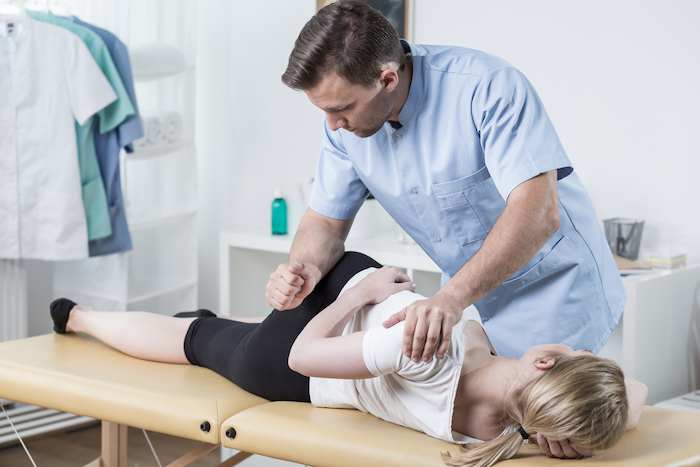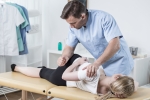
Osteopathic manipulative therapy (OMT) is a treatment method for a number of conditions. OMT is a hands-on technique that involves moving and manipulating a person’s muscles and joints to help diagnose, prevent, and treat certain conditions.
OMT is a treatment option for chronic pain. Although its use appears to be relatively low overall, it is a common treatment for lower back pain.
A doctor of osteopathy (DO) is qualified to perform OMT. These specialists have studied osteopathic techniques and undergone special training in the body’s musculoskeletal system and the interconnected system of nerves, muscles, and bones.
A DO is also sometimes known as an osteopathic physician.
In this article, we outline what OMT is and what conditions it can treat. We also discuss its benefits and what a person can expect before, during, and after treatment.
OMT is a hands-on treatment method that can help diagnose, prevent, and treat a variety of conditions. When carrying out OMT, a DO will use a number of different techniques that move, stretch, and manipulate a person’s muscles and joints.
Medical professionals often split OMT techniques into three categories:
- Direct: Direct methods use an activating force to move tissues through range-of-motion barriers.
- Indirect: Indirect methods place the body in a position of ease during treatment.
- Combined: Combined methods use a mixture of direct and indirect techniques.
These techniques involve DOs moving the person’s limbs into different positions. The DO may also apply pressure to limbs and manipulate the person’s body to stretch muscles and properly align their joints.
A DO may use slow movements and continuous pressure when carrying out OMT, or they may use quick, sudden movements.
OMT should not be painful. If a person does experience pain during OMT, they should let them do know right away.
OMT is a treatment option for chronic pain relating to many different causes.
People with lower back pain or neck pain are the people most likely to require OMT. However, many people receive OMT for a wide and varied range of medical conditions.
Pregnant people can also benefit from OMT. A DO can use OMT to help these individuals deal with pelvic and lower back pain, both during and after their pregnancy.
What conditions does OMT treat?
A person can receive OMT to help treat various conditions, including:
- Asthma: OMT is a possible treatment option to help people with asthma manage their condition.
- Chronic obstructive pulmonary disease (COPD): COPD is an umbrella term for two chronic lung conditions: chronic bronchitis and emphysema. People with COPD sometimes receive conventional pharmacological treatment alongside OMT. Research shows that this combination of treatments can lead to significant improvements in a person’s health, well-being, and daily functioning.
- Musculoskeletal problems: OMT is a common treatment for lower back pain and neck pain. It may also be an effective treatment for carpal tunnel syndrome and, in combination with the medication gabapentin, for fibromyalgia.
- Chronic pain: OMT is a common treatment option for people with chronic pain. OMT can reduce pain levels, improve functional status, and decrease medication use for people with chronic pain conditions.
- Headaches and migraine: OMT is a possible treatment option for people with headaches who either do not wish to use medication or have contraindications to certain medications. Some research also shows that OMT may be a viable treatment option to help people with migraine.
- Pregnancy-related issues: During pregnancy, OMT may help treat certain associated issues, including pelvic girdle pain and lower back pain.
Before a person receives OMT, a DO will assess their specific needs.
A DO may ask the person about their:
- symptoms
- lifestyle
- medical history
- other health issues
- diet
- sleep habits
- mental health
- physical activity levels
The DO can use this information to help tailor their treatment approach. They may also carry out a physical examination of the person, pressing and feeling different parts of their body to try to work out the cause of the symptoms.
During OMT
When receiving OMT, a person may stand, sit, or lie on an examination table.
The DO will then use various techniques to manipulate the person’s body. The person’s specific symptoms and needs will determine which techniques the DO uses.
Common techniques that the DO may use include:
- Massage: The DO may use different types of massage to relax a person’s muscles.
- Stretching: They may use this approach to ease stiff joints.
- Articulation: This technique involves moving a person’s joints through their natural range of motion.
- High-velocity thrusts: The DO might make short, sharp movements of parts of the person’s body. These movements may cause a clicking noise.
The aims of these techniques include:
- Reducing pain
- Improving the range of movement
- Encouraging blood flow
OMT should not cause pain. If a person does experience pain during OMT, they should tell their DO.
Some of the techniques that OMT involves are similar to those that a chiropractor, physical therapist, or massage therapist may use.
However, DOs are able to combine their knowledge of these techniques with their extensive physiological expertise.
After OMT
OMT affects everyone differently. Some people may experience stiffness or soreness after treatment, but this should go away over time.
A person should let their DO know if they experience pain after OMT.
In some cases, a DO may advise a person to follow a few simple steps after they receive OMT. These may include:
- Staying hydrated and drinking plenty of water
- Going for a short walk
- Avoiding hard physical activity for 24 hours
OMT can benefit a person by:
- Decreasing chronic pain symptoms and reducing the use of medication
- Managing their COPD, which can improve their health and well-being and help them function better
- Easing the symptoms of lower back pain
- Managing migraine episodes and easing the symptoms of migraine headaches
- Reducing pelvic girdle pain and lower back pain during pregnancy
- Solving structural issues in their joints and muscles
- Improving joint pain and joint stiffness
- Making the use of certain pain medications unnecessary
Potential Risks And Complications
OMT is a safe treatment for most people, and side effects are rare.
Some people may experience stiffness or soreness after their treatment, but this should go away on its own in just a few days.
A person may experience stiffness or soreness after OMT. However, they should recover within a day or two.
A DO may also recommend avoiding strenuous activity and exercise for a few days.
If a person experiences stiffness or soreness that does not go away after a few days, they should contact their DO.
OMT is a hands-on technique that can help treat a range of conditions. When carrying out OMT, a DO will move, stretch, and manipulate a person’s muscles and joints. This can help them diagnose, prevent, and treat certain conditions.
OMT may be a good treatment option for chronic pain, lower back pain, COPD, musculoskeletal problems, and headaches.
It is a safe treatment with very few side effects. A person may feel sore or stiff after treatment, but that should resolve after a few days.
Precision Pain Care and Rehabilitation has two convenient locations in Richmond Hill – Queens, and New Hyde Park – Long Island. Call the Queens office at (718) 215-1888 or (516) 419-4480 for the Long Island office to arrange an appointment with our Interventional Pain Management Specialist, Dr. Jeffrey Chacko.













